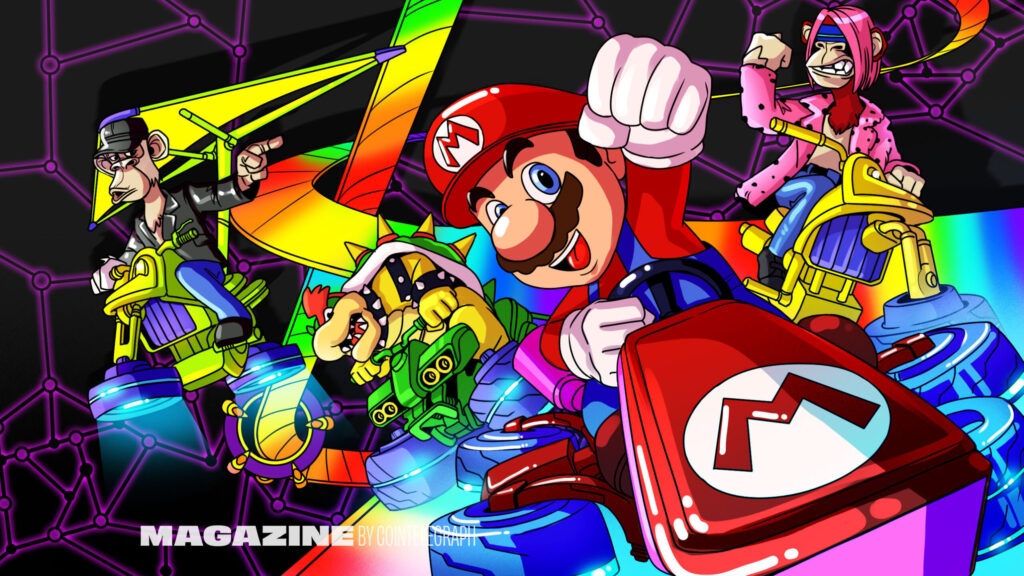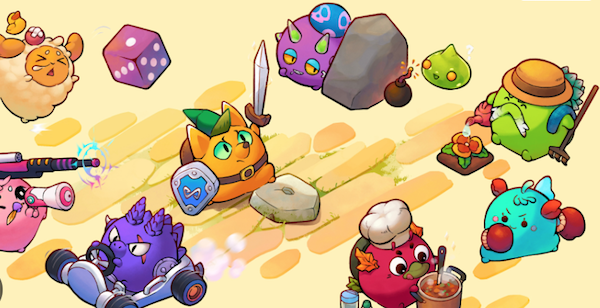

While the thesis is compelling for crypto gaming, the way forward is unclear. Interoperability is one thorny issue and playability is still yet to catch up to traditional games.
Will 2023 finally see an explosion of crypto gaming? The signs are mixed, with former play-to-earn darling Axie Infinity falling out of favor and hemorrhaging players, while mainstream gamers report that Web3 games still have playability issues.
The bright spot is that AAA games are finally starting to emerge in Web3, with projects like Illuvium garnering attention. And theres a ton of runaway, considering that Web3 gaming raised $4.5 billion in 2022. For comparison, metaverse projects raised $1.9 billion.
The thesis is compelling for crypto gaming, but the way forward is unclear. Do tokenomics help immerse gamers in a game, or do they distract from the experience?
I think the first big win will come from a game with tokenomics that dont explode and implode in six months, and that also doesnt feel like a crypto game, Geoff Renaud, co-founder and chief marketing officer of Web2-to-Web3 creative marketing agency Invisible North, tells Magazine.
StepN showed a ton of promise for easy onboarding and user experience but was marred by bad economics. Once theres a game model that feels frictionless where you dont even know youre on the blockchain and that has sustainable incentives for users, there will be a massive follow-on effect. Blockchain gaming needs to have one big win, and I have a feeling thats more likely to be from a simple mobile game that looks like Candy Crush than a AAA title out of the gates.
Getting it right will help unlock mainstream crypto adoption. Illuvium founder Kieran Warwick tells Magazine that blockchain gaming is the best case of onboarding the mainstream to crypto, as its easier to onboard the masses through a game than a complex DeFi product.

Despite compelling numbers, commercial success is hard
Many believe the GameFi sector has a bright future. According to a report by consulting firm MarketsandMarkets, the global blockchain gaming market will grow from $4.6 billion in 2022 to $65.7 billion by 2027. Naavik and Bitkraft Ventures, meanwhile, predict blockchain gaming to grow to a $50 billion market by 2025.
Are these projections plausible? Perhaps. GameFi accounted for 49% of all DApp activity in 2022, according to DappRadar. And there are 3 billion gamers worldwide, about half of which are in the Asia-Pacific region, and mobile gaming is a phenomenon in developing countries.
Yet, the problems facing mass onboarding for blockchain gaming are diverse and complex, including that no one seems to know how the tokenomics should actually work. Many gamers are also aggressively skeptical of crypto games, perceiving them as scams or selfish efforts to monetize gaming and increase profit margins. Moreover, there are no pin-up success stories for crypto gaming outside of relative successes like Axie Infinity and MIR4.
Despite its many critics, Web3 can fit well into gaming culture. Consider existing freemium gaming models (with paywalls). While gamers must buy or grind for the skins (clothes and accessories) and often pay at every turn in these Web2 games, the Web3 model argues that gamers should benefit from secure ownership of their in-game assets.
One goal of Web3 gaming is to let gamers sell or trade unused assets with earning potential, and keep their assets if games are discontinued or go offline. Improved player experiences are also possible, such as players being rewarded for being early or loyal players, meaning they can acquire rare items as new games become popular.

As it was for cryptos cypherpunks, open-source culture is also part of gaming history. At times, game publishers relented to fans hacking their games to make them more challenging and replayable.
As told in Netflixs docuseries High Score, college students hacked and boosted Ataris Missile Command in the 1980s to make the game harder to beat, creating a booming black market arcade in their dorm room and booster kits for the arcade machine. Atari legally settled with the students but only if they agreed to work for Atari. In this conception, gaming IP hacking can escape punishment if youre a true fan helping to improve the game. So, the idea of fan ownership of games makes sense in both crypto and open-source culture.
Similarly, whats happening in Web3 today is an example of a decentralized remix culture where there is a utilization of assets or traits related to those assets, says Kishan Shah, chief operating officer of B+J Studios, which raised $10 million in September 2022 to bring its Raindrops Protocol NFT super app to life for blockchain-based gaming solutions.
Where will the winners come from?
So, among all the different projects currently comprising GameFi, which games will be the most successful? With indie games, the audience is usually looking for something different, which creates an opportunity for blockchain gaming. Smaller publishers are also more likely to develop player-owned or interoperable game economies, as this is not really in the interests of a big studio currently making a fortune by owning everything.
The video games industry does about $120 billion per year in sales, a significant portion of which is virtual goods, noted a16z general partner Chris Dixon, adding that most video games have 100% take rates [commissions for sales]. Web3 (aka crypto) games reduce the take rate dramatically. That is, Web3 gaming can change the whole economic model of the gaming industry.

So, the future looks bright, but getting there wont be easy. Game-making is very hard and highly specialized, and just because crypto firms want to make games doesnt mean they should. Blockchain companies building games is stupid. Game design is a very specialized profession, David Hong, an American based in Taipei who is the gaming lead for Red Building Capital, tells Magazine.
Games should be coming out of gaming studios recruiting blockchain experts.
The big studios also have existing distribution mechanisms and a waterfall cycle for their release schedules. Issues like whether the game will appear on consoles or PC and third-party retail sales can be set years before release, making a newbie upstart challenger subject to numerous obstacles. Then add tokenomics as another complicating factor.
Play2Earn: How Blockchain Can Power a Paradigm Shift in Building Game Economies
Decentralized identity: Proving its really you in the 21st Century
No one gets the in-game tokenomics
One major problem is that sustainable crypto gaming tokenomics have yet to be proven.
Everyone just copied Axies two-token economics, notes Hong. No one really knows yet what the best practices of in-game tokenomics are. Most now argue that pure Ponzi schemes of 99% speculators and 1% players are not sustainable. This is because game-playing enthusiasts know that game mechanics are very intricate, and degens and power gamers will always break the system, Hong says.
Warwick says he called Axie Infinity a Ponzi a couple of years ago, as it required more users to keep entering the ecosystem. Axies were identified as having inflationary properties due to the breeding feature, which resulted in a significant decrease in the value of assets. The abundance of assets created a lack of scarcity, contributing to the devaluation of these assets.
It seems unlikely that Axies developers set out to build a Ponzi scheme, and many pay tribute to the hard work they put in to build what would become a beta test of metaverse gaming. Whats more likely is that they just couldnt make the token economy work without new gamers, like any startup pivoting to find a product-market fit.

Warwick is keen to explain why his game, Illuvium, has learned how not to fall into those traps and how the games story and lore create a scarcity for its NFTs. Illuvials are the games equivalent creature to an Axie.
Fusing three Illuvials of the same stage of the game means burning NFTs and creating one Stage 2 Illuvial. Creating the most powerful creature in the line requires burning nine NFTs.
Sets of Illuvials are also limited. Gamers can collect Illuvials until a series ends, at which point they can no longer capture that set and are forced to purchase them on the open market. Theres also a bonding curve that increases the difficulty of capturing the creatures, meaning that they gradually go up in cost over time. In the game, this means that once an Illuvial is caught, it is harder to find it in the Overworld where it lives.
Furthermore, the concept of real yield, or sustainable revenue for gamers, is also emerging in blockchain gaming. Warwick says:
Baked into our tokenomics is a system called revenue distributions, which means all of the in-game fees that are generated are distributed back to stakers in the protocol. Were the only game that is currently utilizing this method (to my knowledge).
Finally, classes of elements such as wind, water and fire may change in popularity from series to series, so previously undesirable elements may later become desirable. Like Pokemon, you want to capture the most powerful, says Warwick.
While those things create scarcity and help the tokenomics, the game ultimately also needs to appeal to emotions. Like Hong, Warwick believes a games success depends on its ability to tap into the psychology of collecting and creating a connection between the characters and the audience.
For example, Axie Infinity was inspired by Pokemon and Tamagotchi in creating its creatures. Elsewhere, building a universe of characters that players can connect with like with Nintendos Mario, for example and contrasting them with lesser-known characters like Bowser and Wario who are also beloved by players for their distinct personalities helps create a compelling ecosystem. Its important to create characters that players can relate to, even for those who pick Wario because they see themselves as the villain.
Then the main issue for any developer, though, is the exceedingly tricky task of making a good game.
What makes a good game?
We all have our favorite game, from retro classics like Space Invaders and Mortal Kombat to Fortnite, Grand Theft Auto and Halo, depending on our age and tastes.
The story, characters and gameplay are key, as are games with enticing rewards systems that make your hard work worth it unlocking new levels, characters, weapons, secrets and achievements. Gamers are given a reason to keep playing, and blockchain aims to give them digital ownership of the rewards for their efforts.

Good graphics help a lot, too, say most gamers but not always. Some arcade games still captivate new generations of players. Gaming VC Hong is currently obsessed with one very basic game, Torn, for a simple reason: He plays against his brother-in-law. The social element is important, he says, and the community must be authentic. Edgy, colorful, pixelated indie games can offer something that AAA publishers with high-quality graphics cannot.
Difficulty beating the game is another key to a successful game. However, in online games which are arguably the most popular these days its about ranking up, improving skill levels, progressing, getting better gear and cosmetics, and playing with friends.
Like many, Hong argues that Web3 gaming needs incremental changes. It must be palatable for Web2 gamers. What makes you think anyone wants to use a new platform? I still use Word and Excel. There should be value for time spent in the game, but everything else should be the same as Web2 games.
Still, finding a winning crypto game to invest in is hard because Web3 games have not gained traction yet. I dont really get into the details of the game. I dont invest in some drawings and a storyboard. Nobody knows what the market wants. I can only look for good quality teams that understand gaming psychology and good token models, muses Hong.
Hong is still meeting with as many teams as possible every day to find that magical tokenomics model.
There are some interesting experiments going on. For example, Racer Club Labs is creating a blockchain-based BYO (bring your own) tokens racing game for 2,500 NFT communities. In each Racer Club, there are 10 heroes created via the IP assignment of existing NFT holders from the collections of those communities.

So, say that during the club creation phase, a Mutant Ape Yacht Club NFT holder assigns their unique 2D NFT to be immersed as a 3D hero character in an MAYC Racer Club. When this happens 10 times, the MAYC Racer Club becomes a 10-set club license, and it can be held, traded or sold individually.
By using existing NFTs and tokens rather than issuing new ones, the idea is to create scarcity.
To date, gaming still has no proven tokenomic model. Esports is the start-off bridge to the mainstream. My prediction is that whoever does it right wins the race this year, Racer Club Labs co-founder Matt Ng opines.
While Racer Labs is built around using NFTs from elsewhere, there seems to be little chance that the major companies will adopt this model. Warwick says its a pipedream:
The interoperability conversation is bullshit. Widespread interoperability is a lofty goal that is likely decades away. The idea of having characters like Mario from one game appearing in another game like Call of Duty is unrealistic. There are many technical and logistical factors that need to align for interoperability.
However, he believes interoperability will begin to occur within games in the same franchise or from the same studio.
The move from play-to-earn to play-to-own to play-and-develop
Lifelong gamer Elisabeth Hare tells Magazine that gamers need more and that blockchain can give it to them. We need a paradigm shift where the power comes back to the people. One reason blockchain gaming is needed is because of the state of gaming today. Gamers dont own what they are buying, and they constantly need to buy things.
She concedes that poor behavior by game developers, like releasing buggy games built around monetization, has soured the appetite for blockchain gaming.
Take Overwatch, for example. Activision Blizzard essentially gutted the game, rereleased it as a sequel and heavily monetized it. The actual new element of the game has been delayed at least a year. This is one of the reasons why Im not surprised gamers are skeptical about monetization.
Hare believes that games need gameplay mechanics that are not just based on earning. She is waiting for one or more great Web3 titles to prove her ideas right. The perception in the gaming community is that NFTs provide more ways to extract money from the consumer. Its a money grab.
This makes education important, along with careful design. For example, when AAA studio Ubisoft released NFTs, there was a resounding backlash from gamers. Ubisoft responded that gamers didnt understand NFTs.
With emerging and controversial tech, gaming companies need to clearly demonstrate the benefits of that tech, or implement it in a way thats appealing or essentially invisible, Hare says.
There needs to be a shift in the way NFTs and Web3 concepts are communicated to gamers, in that the Web3 parts should be hidden in the product, says the lifelong gamer.
And while a Fortnite skin NFT in Minecraft might still be a while off, the search for the Web3 gaming gem continues.
Crypto leaders are obsessed with life extension. Here’s why
The value of a legacy: Hunting down Satoshis Bitcoin




